On October 11 2022, Vera Pauw cemented herself into Irish history by guiding the Republic of Ireland women’s national team to the FIFA Women’s World Cup for the first time ever with a 1-0 victory over Scotland at Hampden Park.
In fact, it was the first time in 20 years that Ireland qualified for a World Cup, including the men’s team.
Amber Barrett’s clean strike into the bottom corner past the Scottish goalkeeper sealed qualification for the Girls in Green as the country gleamed with pride.
Regardless of what happens in Australia, Ireland can be proud of achieving a feat that no group before them could. However, the ultimate end goal will be to reach the knockout phase of the contest. Everyone is happy to take part until the referee blows the first whistle.
Ireland’s squad may not be one of the strongest heading down under but there is obvious quality within the ranks, including the likes of Denise O’Sullivan, Katie McCabe, Diane Caldwell and Louise Quinn. Vera Pauw knows what her best team is and you can guarantee she’ll play in a manner and within a structure that will be best suited to pick up results.
There are some excellent teams in Ireland’s group, including hosts Australia, Canada, and African giants Nigeria so progressing through the group will be a monumental task. But Ireland is a country historically known for overcoming the greatest of obstacles, and anything can happen in tournament football.
One thing is for sure, Pauw will need to get her tactics spot on in each game if Ireland are to progress from the group stage and defy all expectations for themselves.
This tactical analysis piece will be a team scout report of Ireland ahead of the WWC. It will be an analysis of the tactics that we can expect from Pauw’s Ireland this summer.
Predicted Starting XI
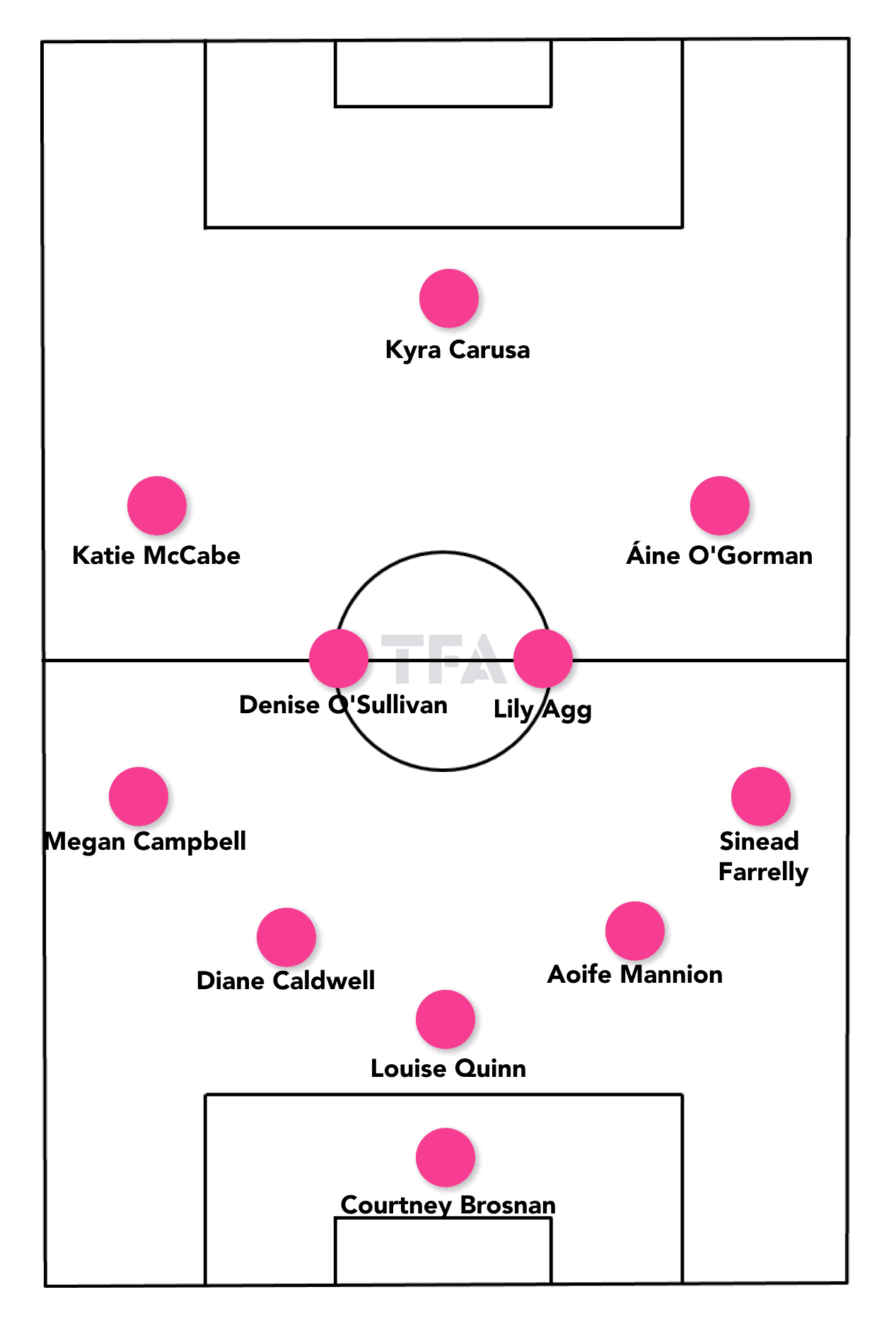
Picking Ireland’s primary XI was a tough ask ahead of the WWC. Pauw has rotated a lot of players into several different positions depending on the opposition on the day. For instance, Katie McCabe has played at both left-wing and left wing-back while Megan Connolly has been used as both a midfielder and a centre-back.
What has been a constant, though, is Ireland’s formation choice. The Dutch manager has yet to divert from the 5-4-1 shape which turns into a 3-4-2-1 when in the attacking phase, as we’ll get onto shortly. The European minnows will likely be set up in a 5-4-1 ahead of this summer’s coveted competition.
Courtney Brosnan has been the preferred candidate between the sticks for Pauw while the back three will likely be comprised of Manchester United defender Aoife Mannion, Louise Quinn and Diane Caldwell. There is a massive question mark over the fitness of Mannion who is recovering from an injury as of writing this but the Irish camp are positive for her return.
At wing-back, we could have selected McCabe on the left as she has played that role under Pauw but have opted to go with Megan Campbell to allow McCabe to play further forward while we’ve decided to go with the rogue shout of Sinead Farrelly at right wing-back who has just recently made her debut for the national team at the ripe footballing age of 33.
On the right, it may well be a whole host of players, including Áine O’Gorman, Farrelly in her preferred advanced position or even Heather Payne who has also played that position in the past. However, we have selected O’Gorman purely on the basis that she played on the right in the playoff match against Scotland and, due to her attack-minded nature, she can invert and link up with the centre-forward.
In the double-pivot slot, Denise O’Sullivan is almost a dead-cert to start due to her incredible technical skills and line-breaking ability alongside Lily Agg as the duo complement each other really well.
Up top, there were several selections but Kyra Carusa did extremely well in a recent friendly against the USA and so we believe Pauw will keep her in the team, although the head coach may prefer to go with someone like Amber Barrett who scored the all-important goal against Scotland to qualify for this tournament in the first place.
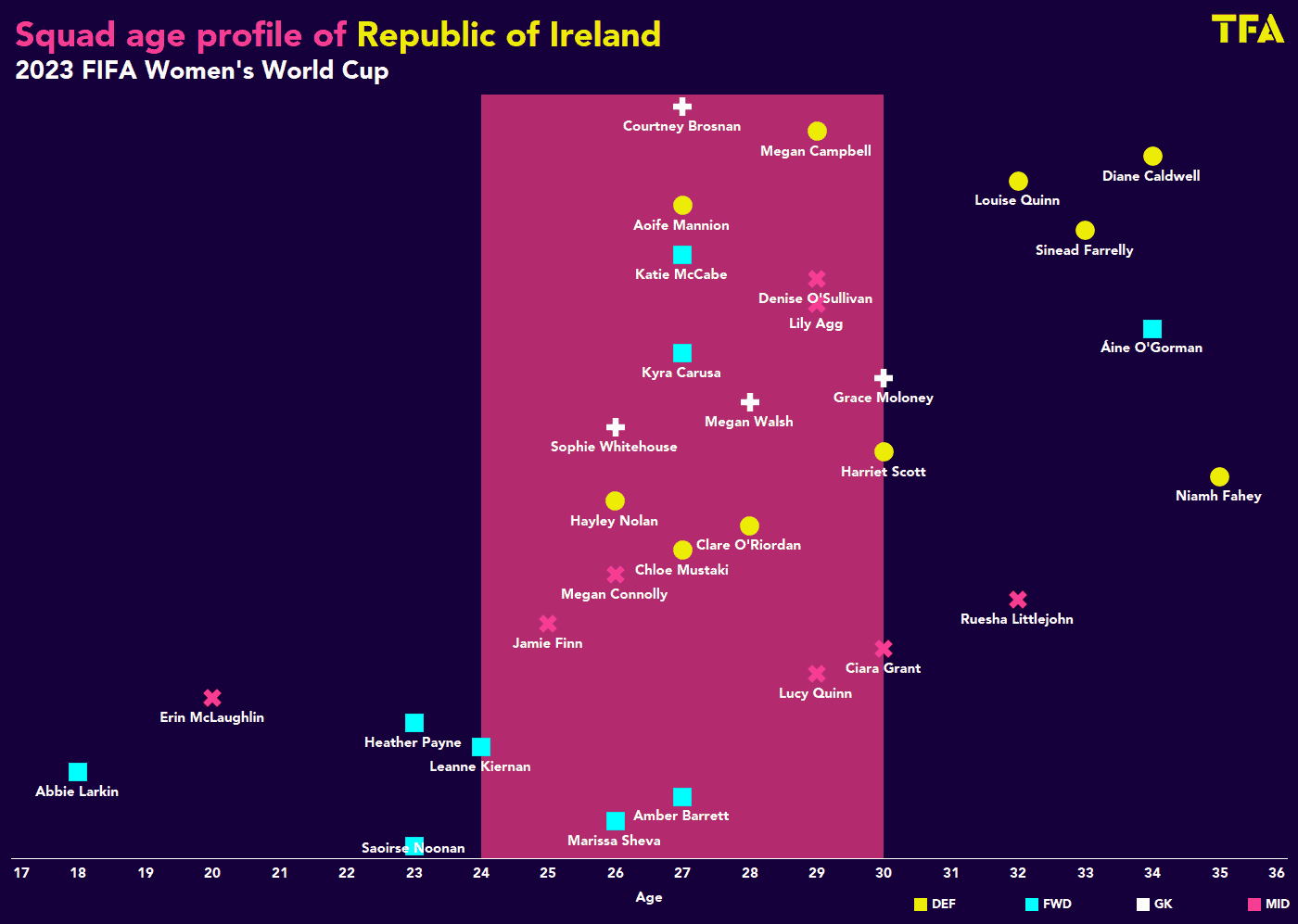
As we can see from this data viz which displays Ireland’s provisional squad ahead of the WWC, with the sneaky inclusion of the questionably fit Mannion, there is a nice blend of youth and experience, although there is far more experience in our predicted lineup than youth. Pauw will be relying on the experienced heads of her team to grind out results against some tough opposition.
But with the team composition now set, let’s take a look at the tactics that we can expect from Ireland ahead of the Women’s World Cup this summer.
Attacking Phase
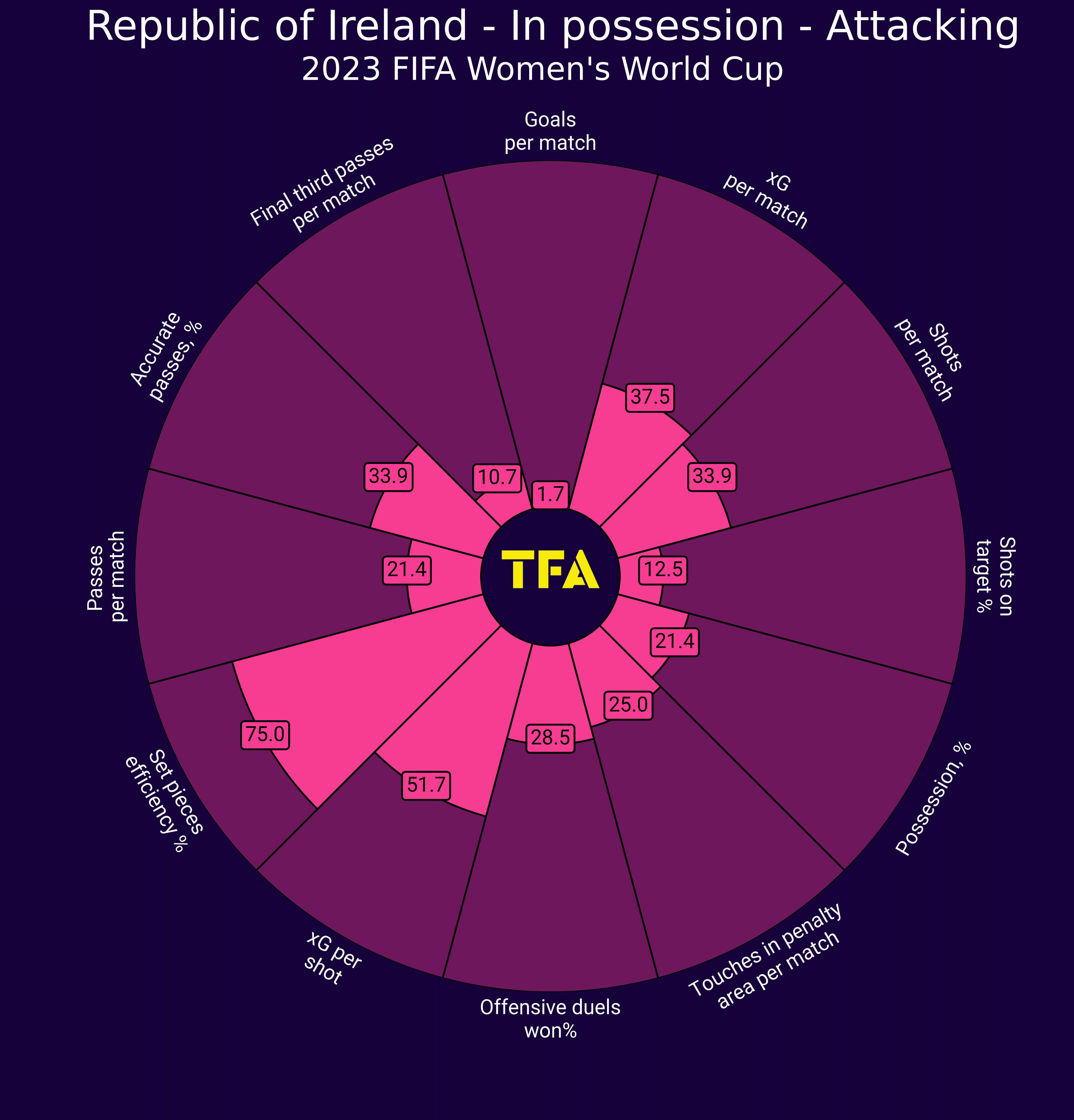
Ireland are a team that are able to adapt to the quality of the opposition. Unless you are one of the strongest sides in the world, teams must have this ability to bend — otherwise, they will break.
Much has been made of Vera Pauw’s tactical approach in games. Comparisons have even been drawn with Jack Charlton’s infamous Put ‘Em Under Pressure tactics from Italia ‘90 when Ireland reached the quarter-finals of the Men’s World Cup playing a style of play that could look abhorrent, at times, to purists.
While many didn’t care as the team was enjoying success on the pitch, there was a loud minority of critics who slammed the Leeds United great for his approach despite possessing arguably the greatest crop of Irish talents in living memory.
This loud minority have come out of the woodwork once more to put down the Dutch coach’s tactics ahead of a major tournament — a gang perhaps poisoned by Pep Guardiola’s success, believing that playing beautiful football leads to success and that this style is applicable regardless of the resources available. A collection of people who believe there is a right or wrong way to play the game.
Nonetheless, Pauw’s methods have borne delicious fruit already and switching to a more expansive style could hand Ireland the wooden spoon. As Vera herself said, “the low block is not me but is what this team needs to perform and win. If you open yourself up, you could lose 5-0.”
Labelling Ireland a ‘route one’ side is remiss. The Girls in Green will play direct when necessary, but when faced with lesser opposition, will have no issues with dominating the game.
In the 1-0 win over Scotland back in October, Ireland held just 35% of the ball. In the very next game, against a weaker Morocco, this number jumped up to 60%, showing the adaptability of the team’s style. Furthermore, across the most recent two friendlies versus the United States, Ireland had merely 32% of the ball in the first fixture, eventually losing 2-0. In the second game, the USWNT scored relatively early into proceedings but Ireland battled hard to find an equaliser, boasting 51% of the ball against the reigning world champions.
The attacking tactics used by Vera Pauw are logical and get the best out of the players she has available. Given Ireland play in a 5-4-1 out of possession, this becomes a 3-4-3 in possession, or primarily a 3-4-2-1 with the two wingers acting as number ‘10’s.
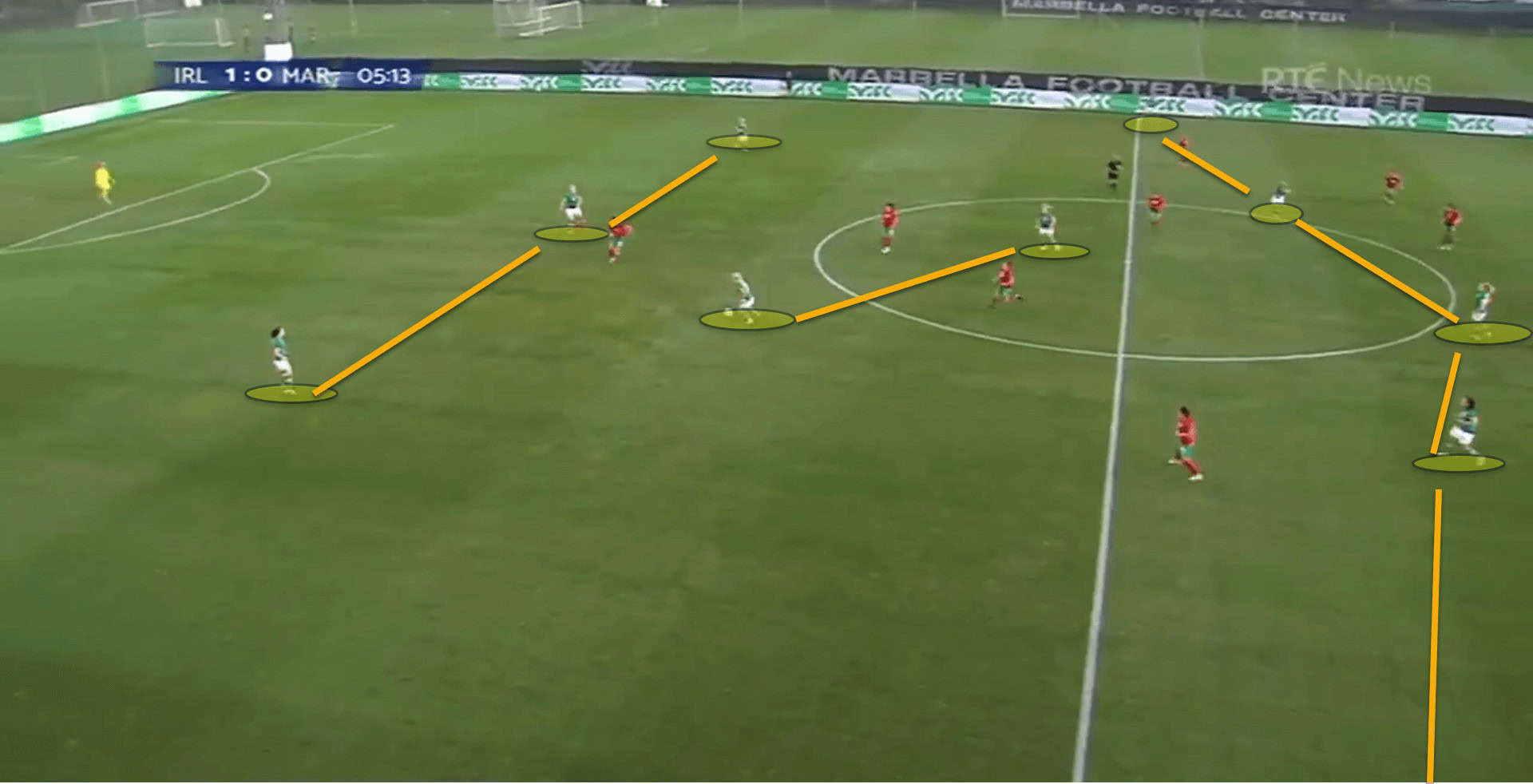
The wing-backs push very high up the pitch to offer width since the wingers invert and so the structure is very much a 3-2-5. Against a back four, having these five players on the same line in advanced areas allows Ireland to overload the opposition’s backline, but they can also go 1v1 when faced with a back five.
There is a very distinct pattern of play that Ireland use during games that has clearly been rehearsed in order to try and build up play from deep as quickly and as efficiently as possible.
Given that the centre of the pitch is always the most congested, Ireland use the wide centre-backs to initiate progression by having them play the ball out to the nearest wing-back.
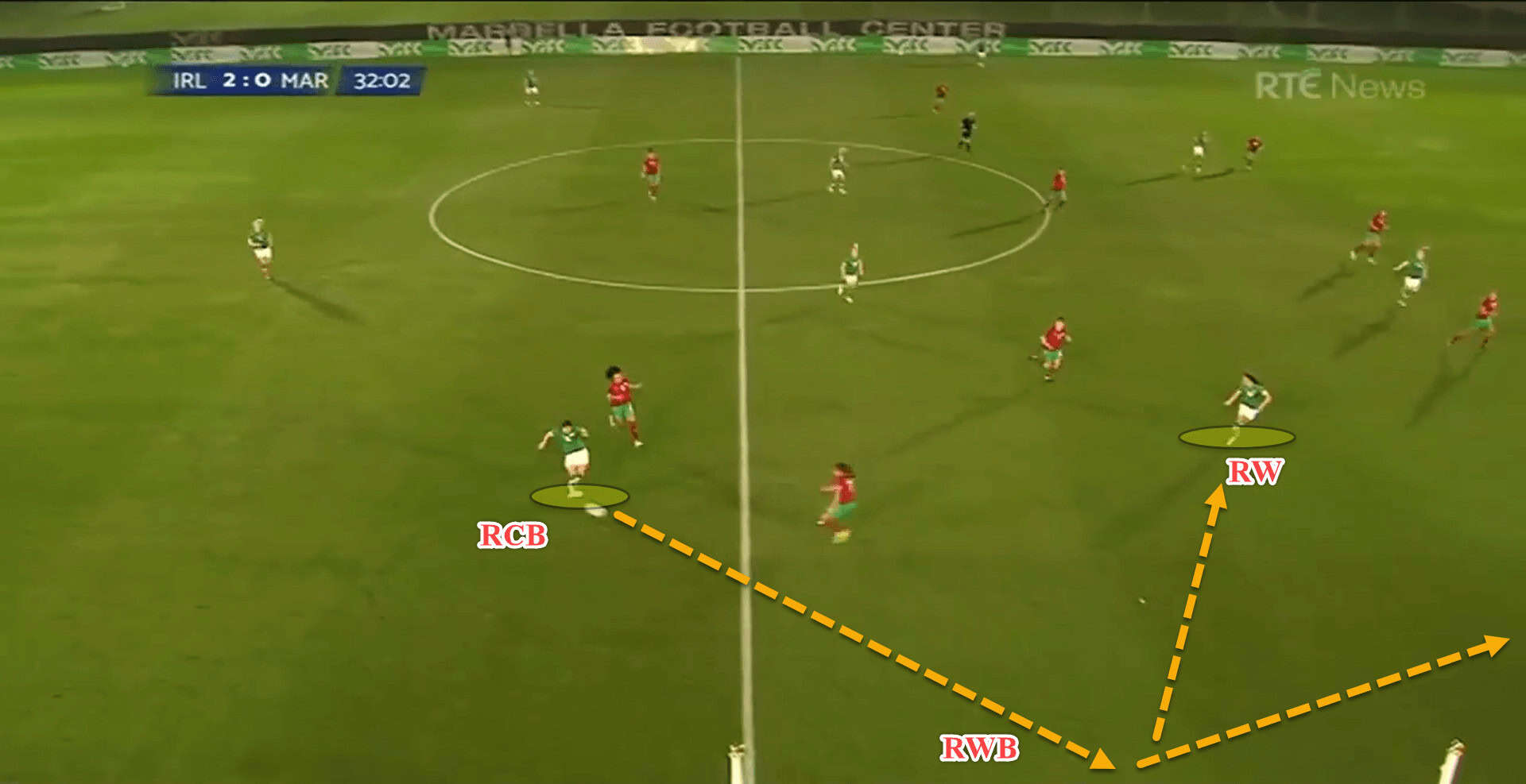
Once the wing-back receives possession in an advanced position, the inside winger begins to set themselves to receive either to feet in the halfspace and perhaps play a one-two with the wing-back or else latch onto a through ball in behind.
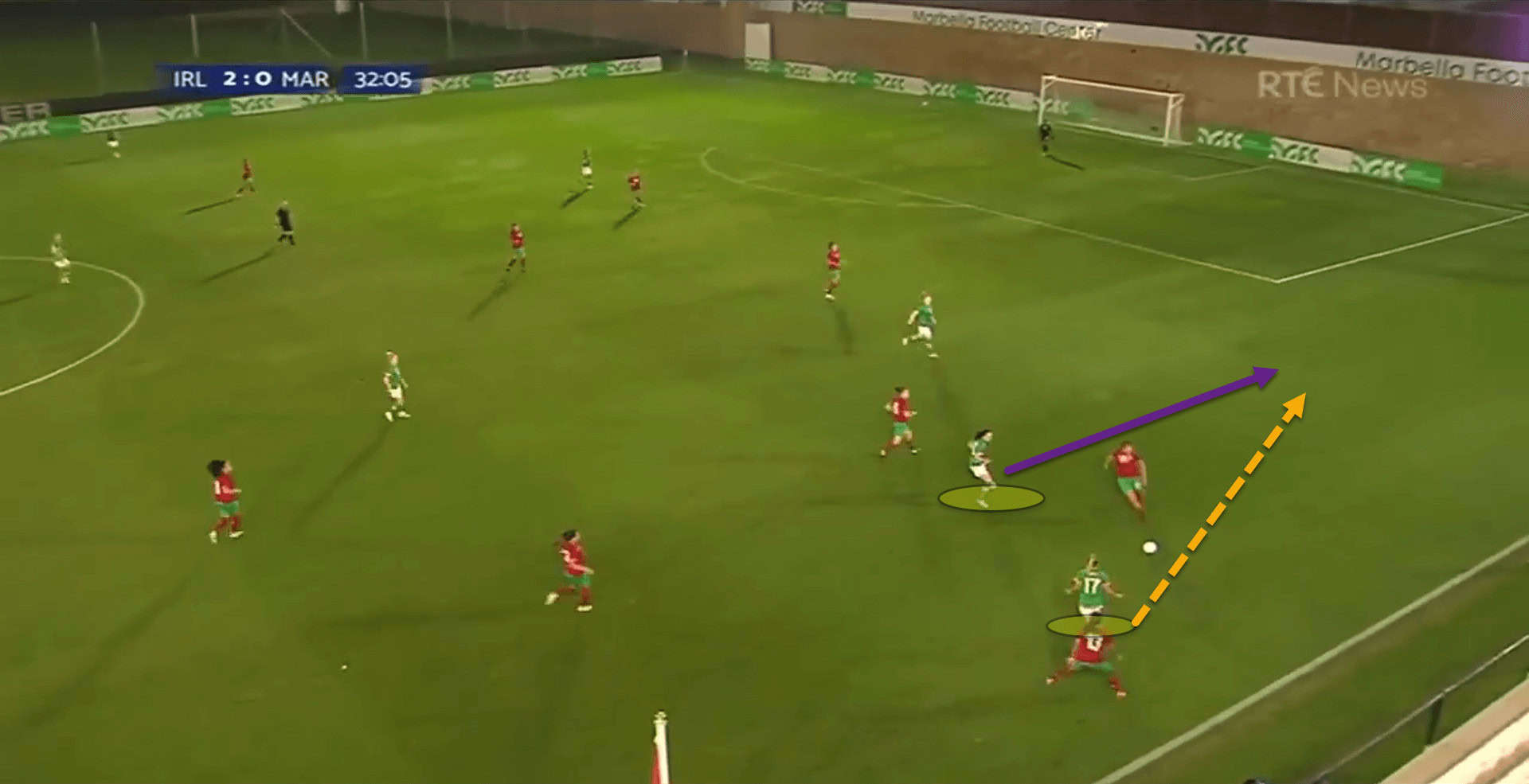
In this instance, it was a through ball straight from the wing-back in behind the Moroccan backline. The move didn’t quite work out but it was a matter of two passes which could have broken through the opposition’s mid-block and put Ireland in a dangerous position to create a chance.
Ireland aren’t really known for building out from the back under Pauw, particularly against stronger opposition. This is quite telling by the team averaging 2.82 passes per possession.
Furthermore, 15.81% of Ireland’s passes over the past calendar year have been long balls. For context, Ireland’s opponents have averaged 12.47%.
Look at goalkeeper Courtney Brosnan’s pass map from the double-header of friendlies against the United States. Most of her passes were long balls forward or switches of play out to the wing-backs.
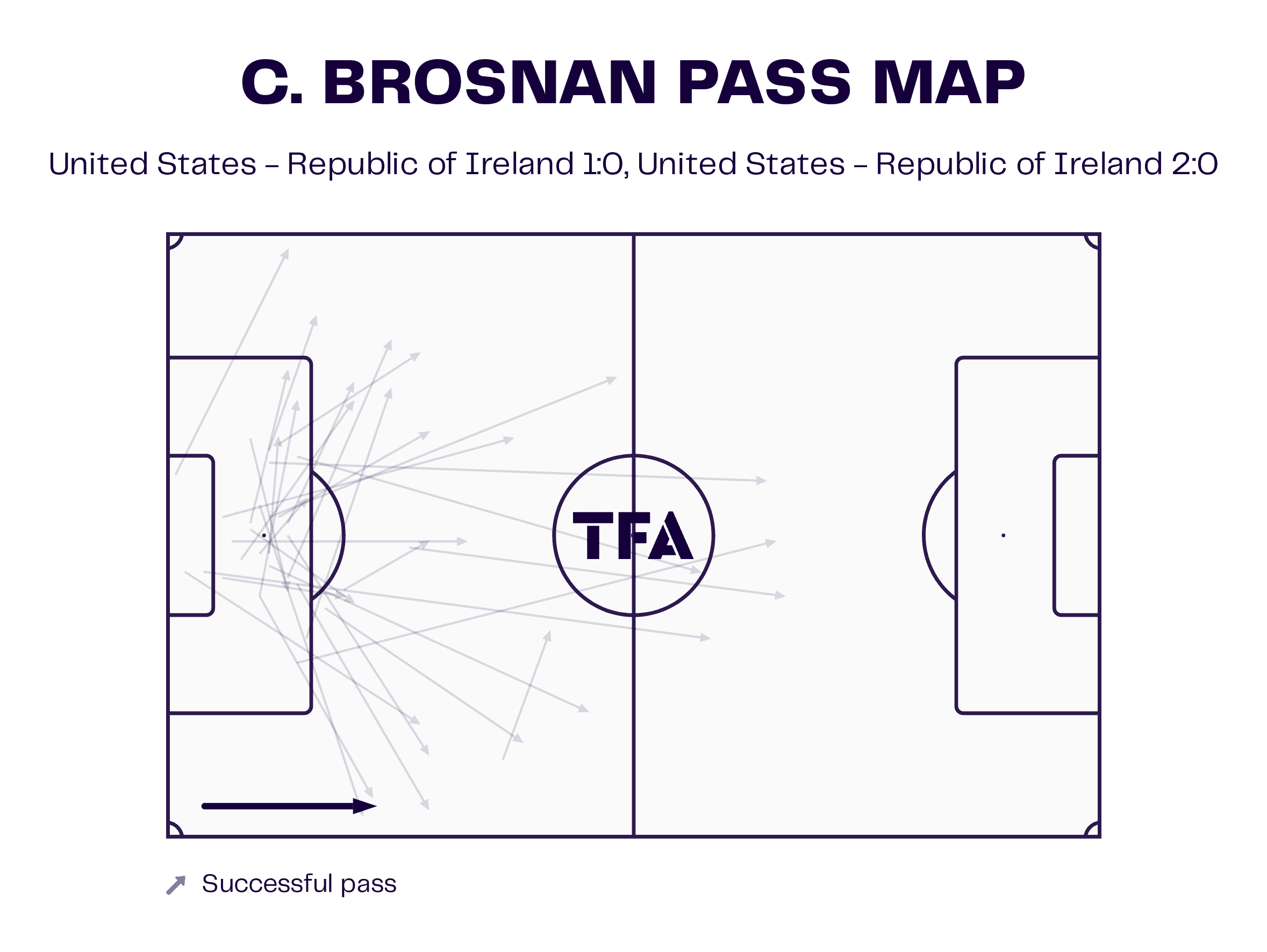
This has actually been problematic for Ireland. The USWNT knew that by pressing narrowly and cutting off passing lanes through the centre of the pitch during the high block phase while also leaving the wing-back passing lanes free, Brosnan would attempt these switches out wide.
Quite often, the Everton goalkeeper took the bait and would attempt to make these passes but the ball would be overhit and fly out of play for a throw-in to the opposition.

For the most part, Ireland will go long to the forward line, bypassing the opposition’s press by simply playing over it rather than through it.
To play in such a manner, you need a centre-forward who is OK with being isolated for long periods of the game or ‘left cold’ as it was described by retired international Karen Duggan when criticising Pauw’s style of play.
Kyra Carusa or Amber Barrett have been the Dutch manager’s preferred options up front as the duo work very hard when constantly chasing shadows.
The striker must always be willing to challenge in aerial duels too. The objective is not to win the aerial battle, but to simply put the defenders off, stalling the move while the midfield step up to help win the second ball.
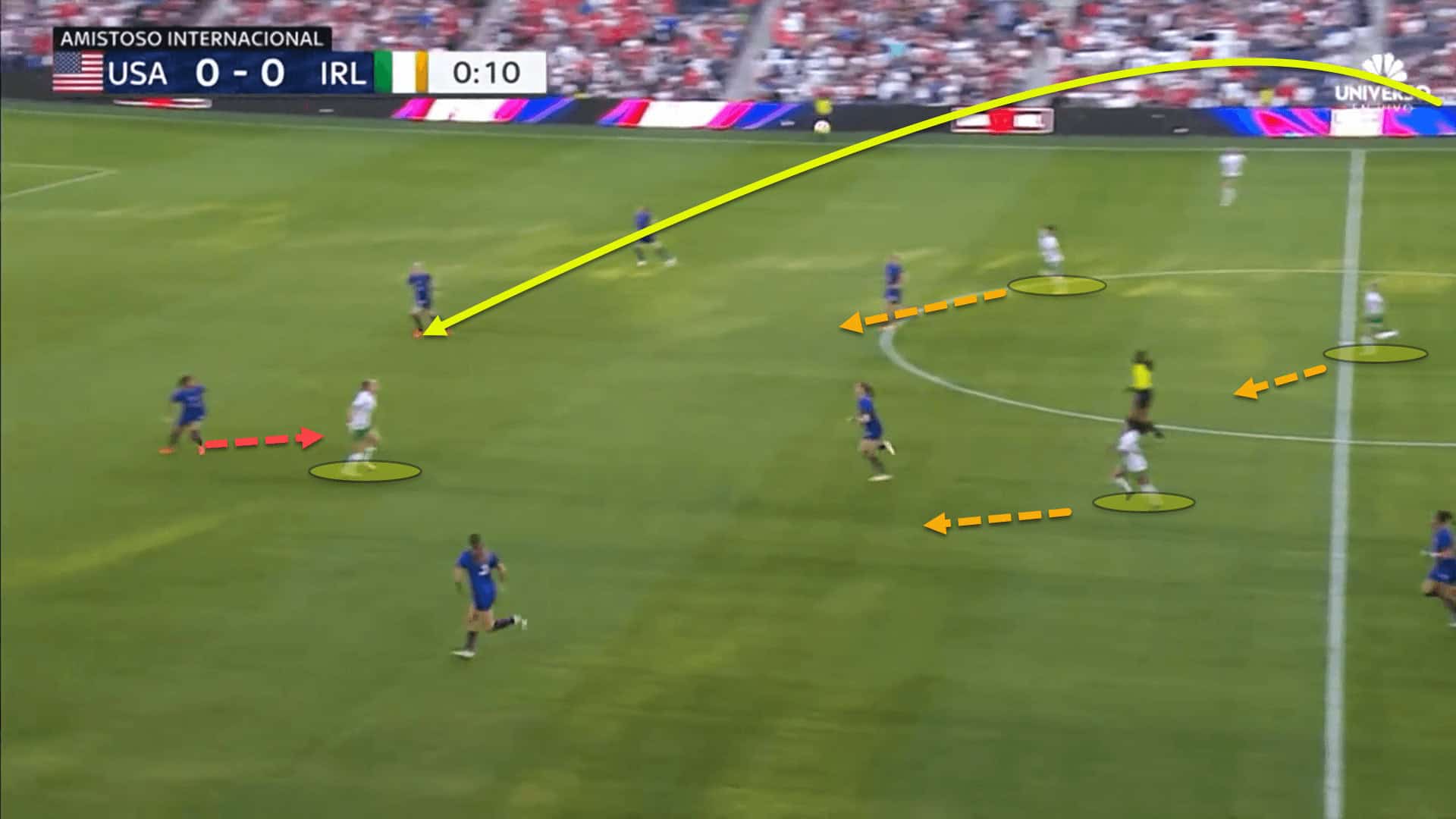
When Ireland do eventually get the ball into the final third, Pauw doesn’t hold her players back. For all the criticisms of Ireland’s style of play, the head coach instructs her players to pack the box with at least five at a time, meaning the Irish team are a threat to any side. The USA know this better than any team. Across the two friendlies in America, Ireland created an xG of 2.71. Unfortunately, nobody could find the net but the chances were still being created.
The wing-backs are instructed to put crosses into the penalty area while the rest of the team try and fill the penalty area to latch onto a delivery.
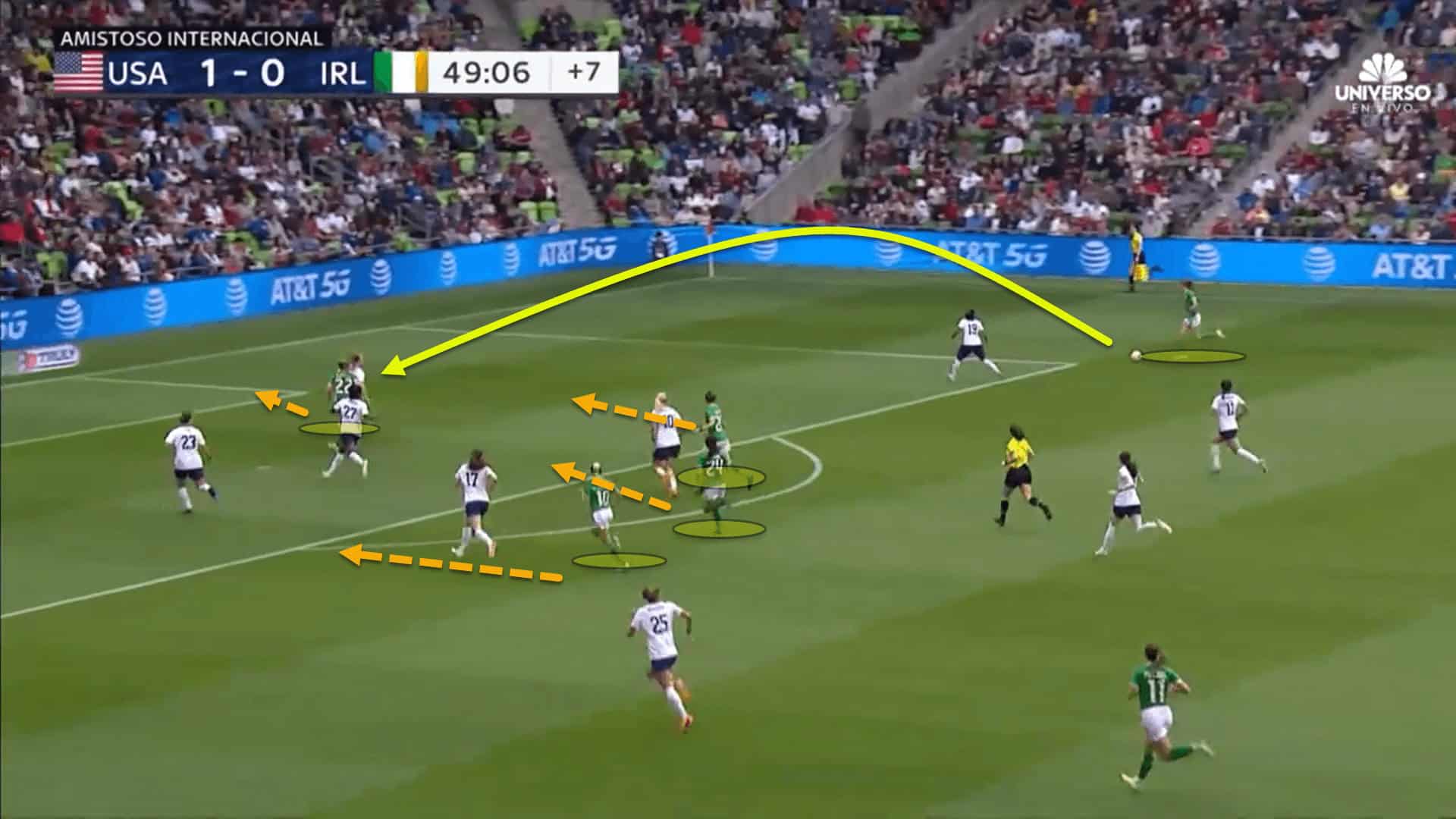
By having a high volume of players in the box, it brings about a higher probability that a rebound or scuffed clearance will fall to an Irish player too.
Over the course of the 2023 WWC qualifying campaign as well as the friendlies played this year, Ireland have been quite potent in front of goal.
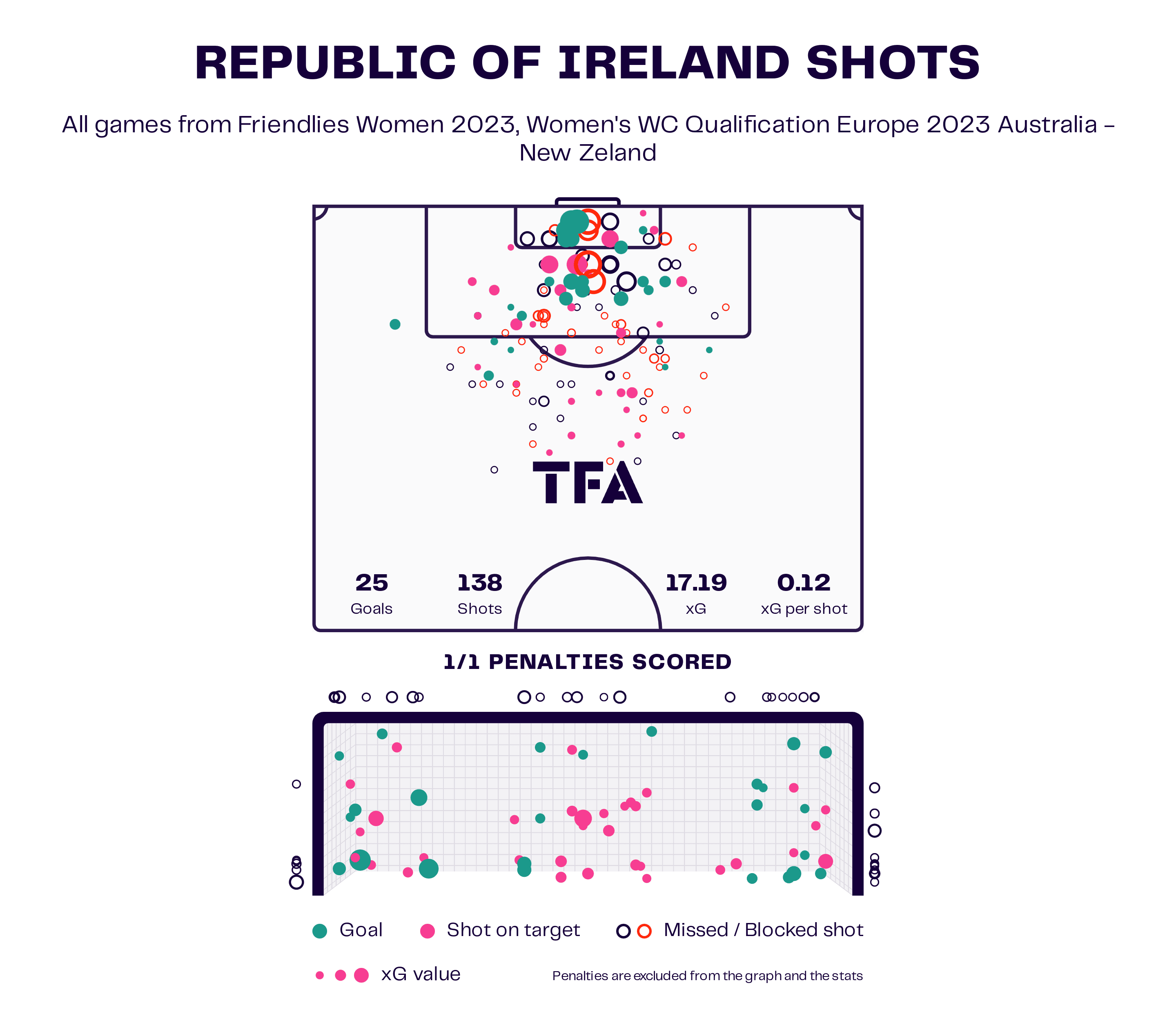
25 goals from an xG of 17.19 is a massive overperformance and tells us that when Ireland get a chance at goal, they have the quality to tuck the ball away.
Ireland may defend for long periods of this World Cup but the team’s ability to be a threat in front of goal cannot be underestimated by any opposition. The Irish are as dangerous as ever.
Defensive Phase
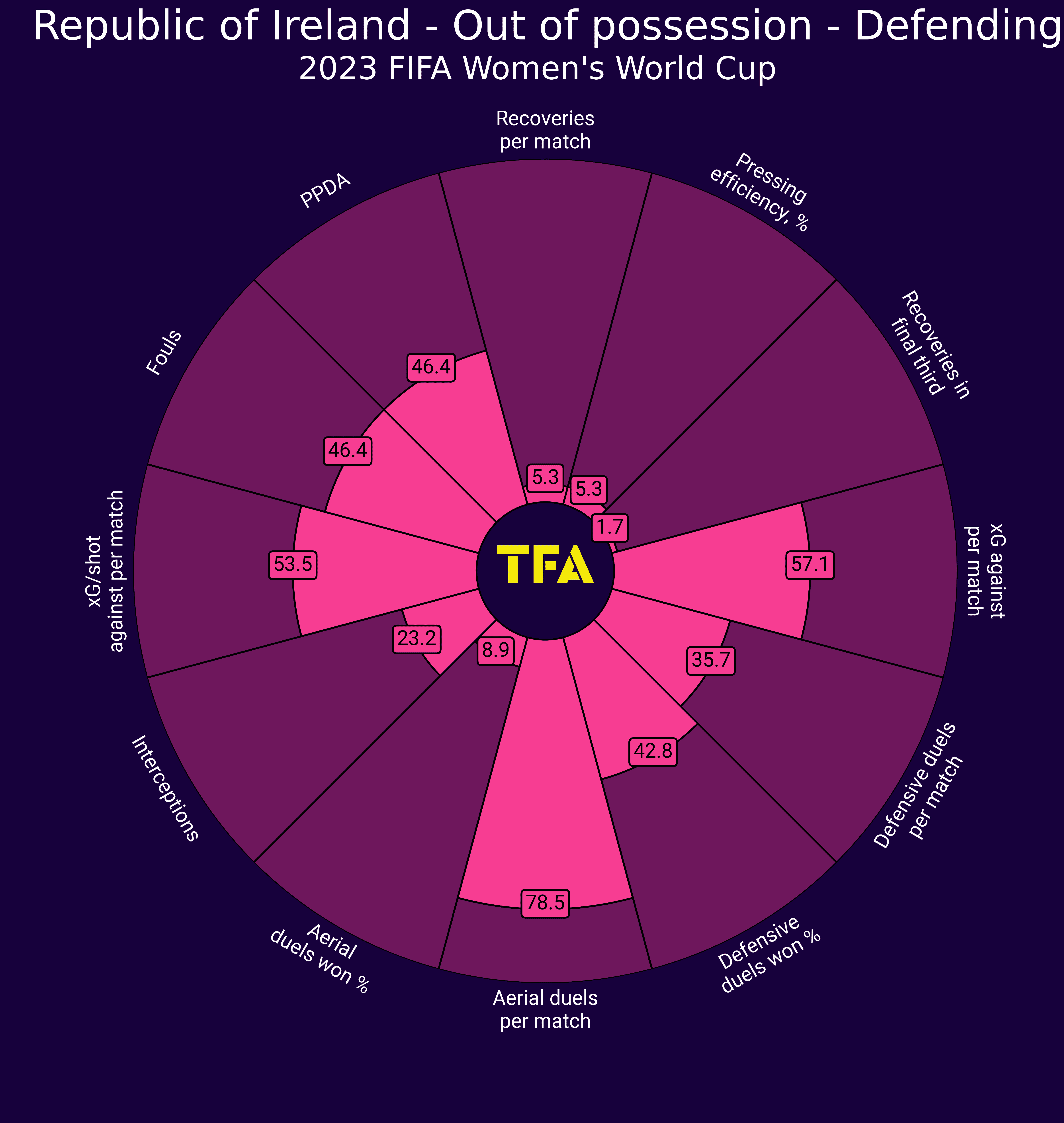
Ireland are incredibly rigid in the defensive phase. Pauw wants her side to defend for as long as possible in a mid-block but the Irish side are fine with dropping into a low block and defending for extended periods of time.
Pauw’s ladies attack in a 3-4-2-1 but the wing-backs quickly fall back alongside the three centre-backs during the mid-to-low block phase, forming a tight 5-4-1 structure.
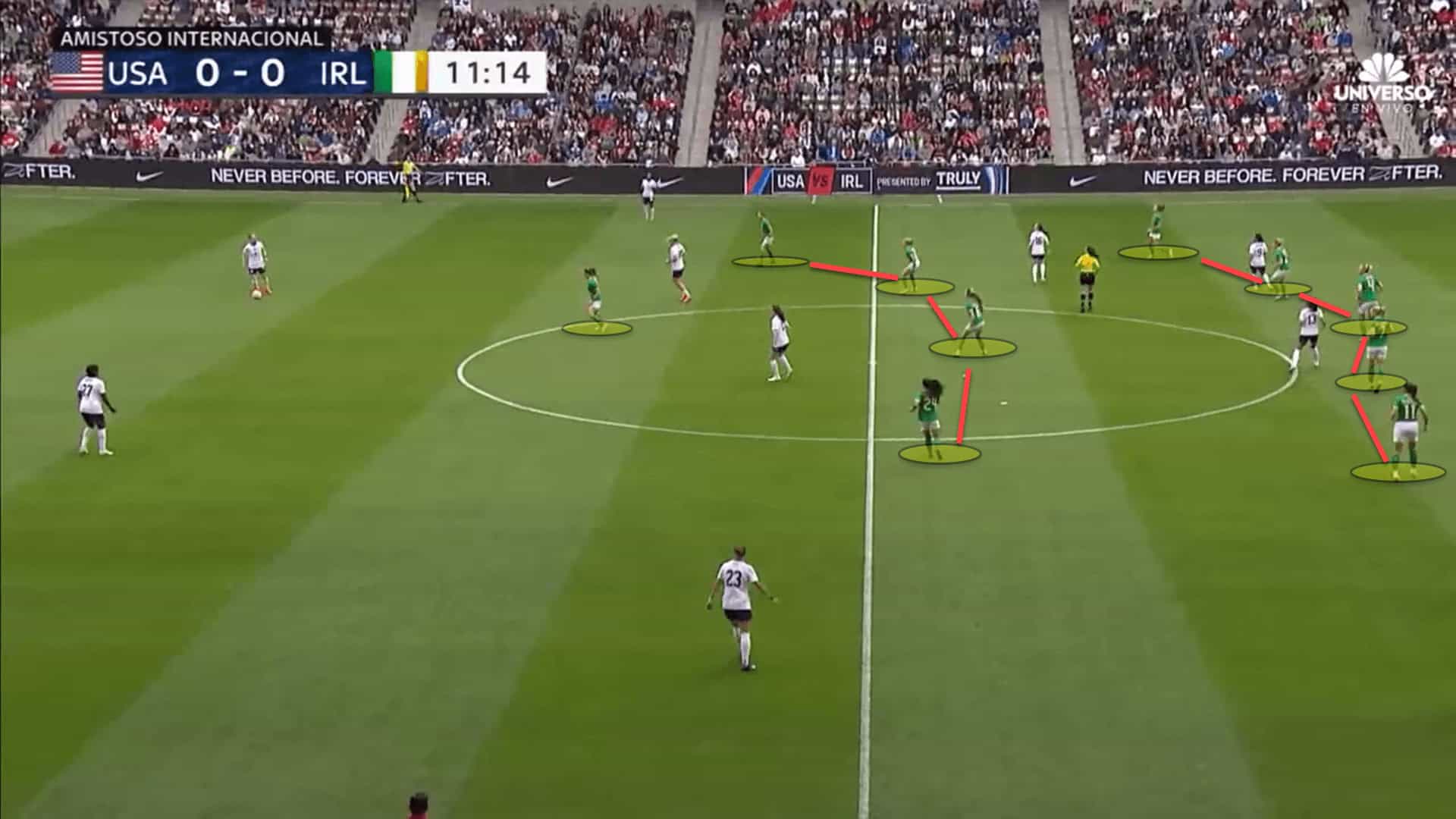
The space between the lines is very compact. Pauw wants to ensure that the opposition cannot play through the central areas as this is the area of the pitch where better opponents tend to have their most creative players, hoping to unlock the Irish defence.
If the ball does reach the spaces behind Ireland’s double-pivot and in front of the defence, the nearest centre-backs step out of the backline to help jump the ball receiver from behind. In this respect, the backline works in unison with the midfield.
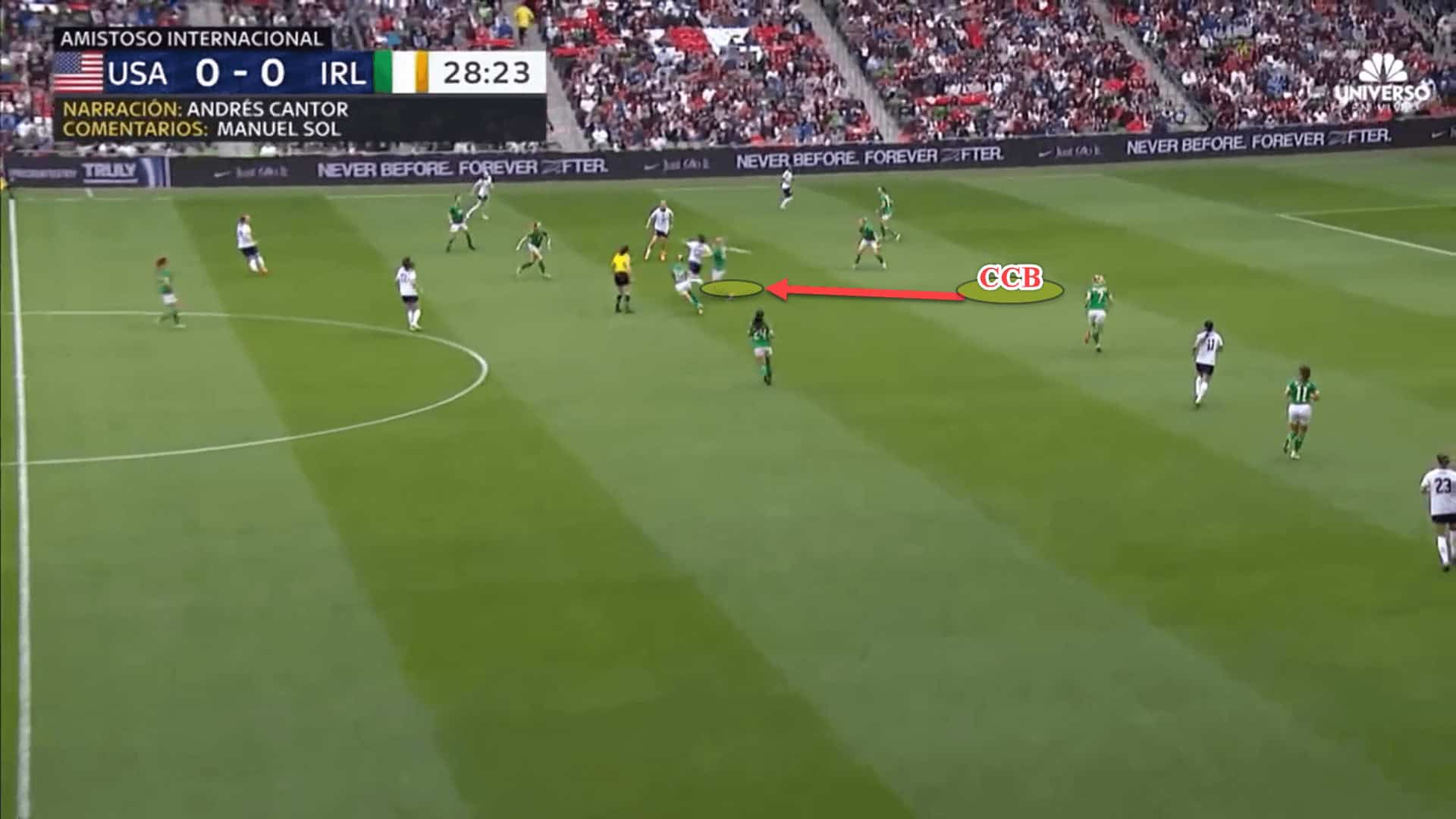
However, this is only possible if the lines are very close to one another. If the midfield and backline were too far apart, it would be next to impossible for one of the back three to step up with enough time to prevent the receiver from turning and potentially playing a line-breaking pass.
Thankfully, Vera Pauw can rely on her backline, comprising of the experienced WSL defender Diane Caldwell as well as Manchester United stopper Aoife Mannion.
Each line needs to work in tandem for prolonged spells of the game for Ireland’s defensive block to be effective. When the midfield and forward line are stepping up to press, perhaps after a backward pass is played, triggering the Irish team to bring the lines up, the defence must step up too or else there will be far too much space between the lines.
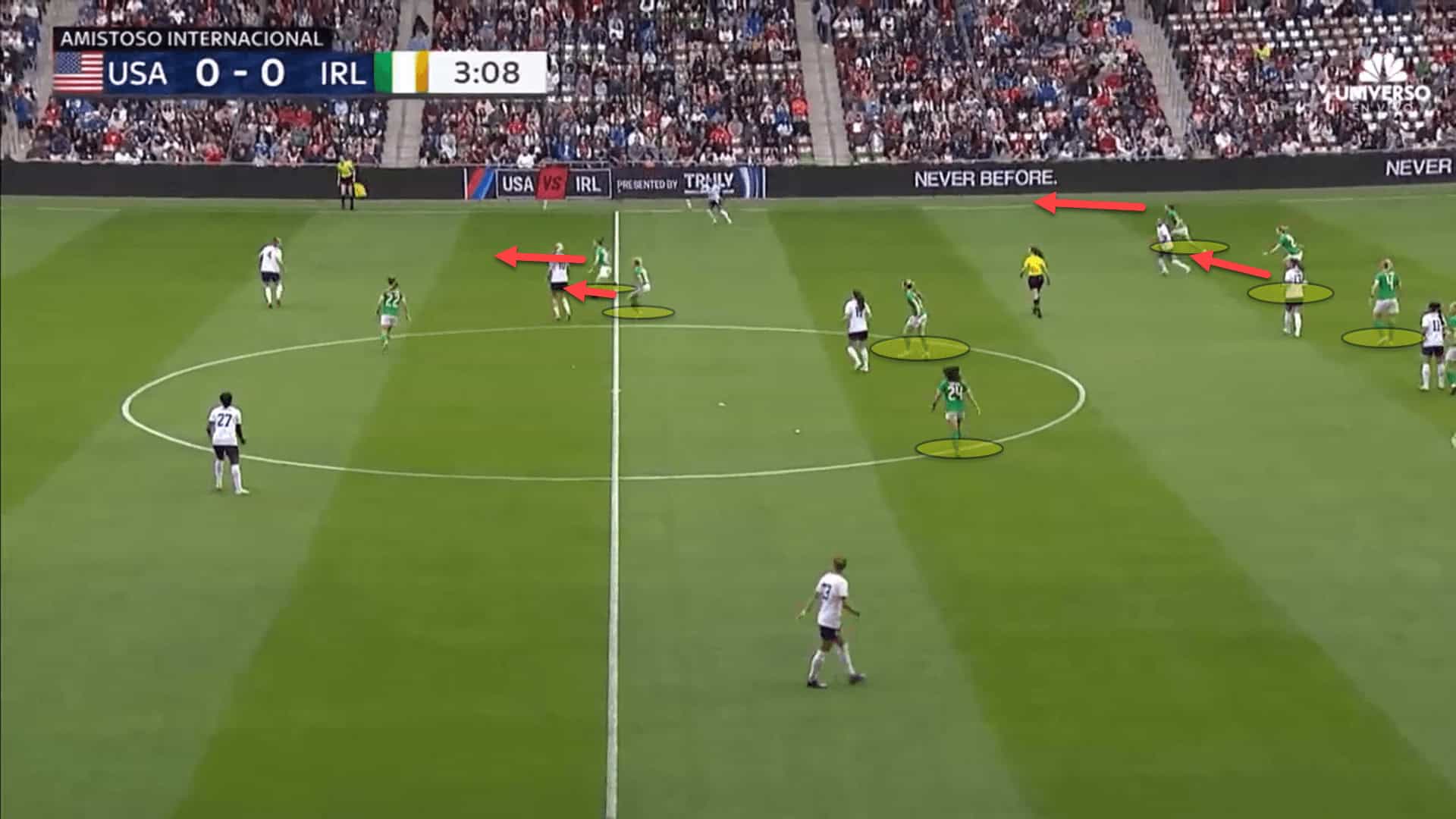
Ireland’s objective in the mid-to-low block phase is to force the opposition to play out wide. From there, the team shift the block across to try and regain possession, using the touchline as an extra defender to make it really difficult for the opposition to break through to the final third.
Newcastle United employed a similar strategy under Rafael Benítez when the team had limited funds during the Mike Ashley era. The Magpies defended in a 5-4-1 mid-to-low block and would aggressively press in the wide areas to win the ball back before transitioning forward.
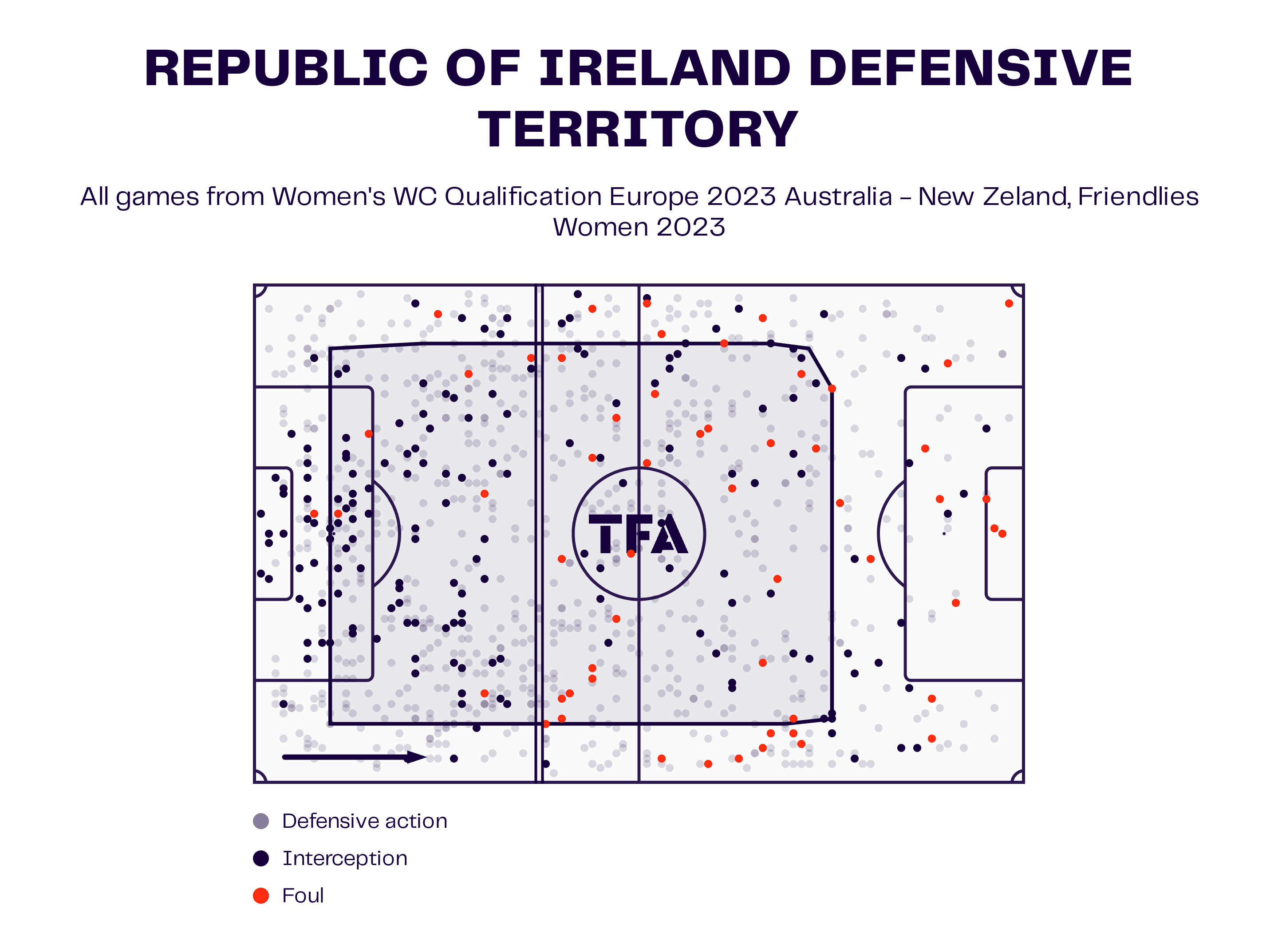
This data visualisation shows Ireland’s average defensive line height and territory during the 2023 WWC qualifiers and during their most recent friendlies against the USWNT. Notice how many ball recoveries are in the deeper wide areas and even in the halfspaces when the centre-backs would step out of the backline to close down players between the lines
The team’s defensive record over the past year has been quite impressive too. In total, Ireland have conceded an average of 0.43 goals per 90 which is really low while also allowing 1.08 xG per 90 against them
The naysayers can criticise Pauw’s pragmatic approach in games but these defensive tactics have meant that Ireland are conceding so few goals which has been a massive factor behind the side’s first-ever qualification for the Women‘s World Cup.
Referring back to the manager’s quote about deploying a low block, “if you open yourself up, you could lose 5-0,” and so Pauw prefers to take a conservative approach in games to avoid being ripped apart at the back.
The Irish team have also proven to be excellent during the emergency defending phase. This is when structure and shape go out the window and the objective is to simply stop the ball going into the back of the net after the block has been penetrated.
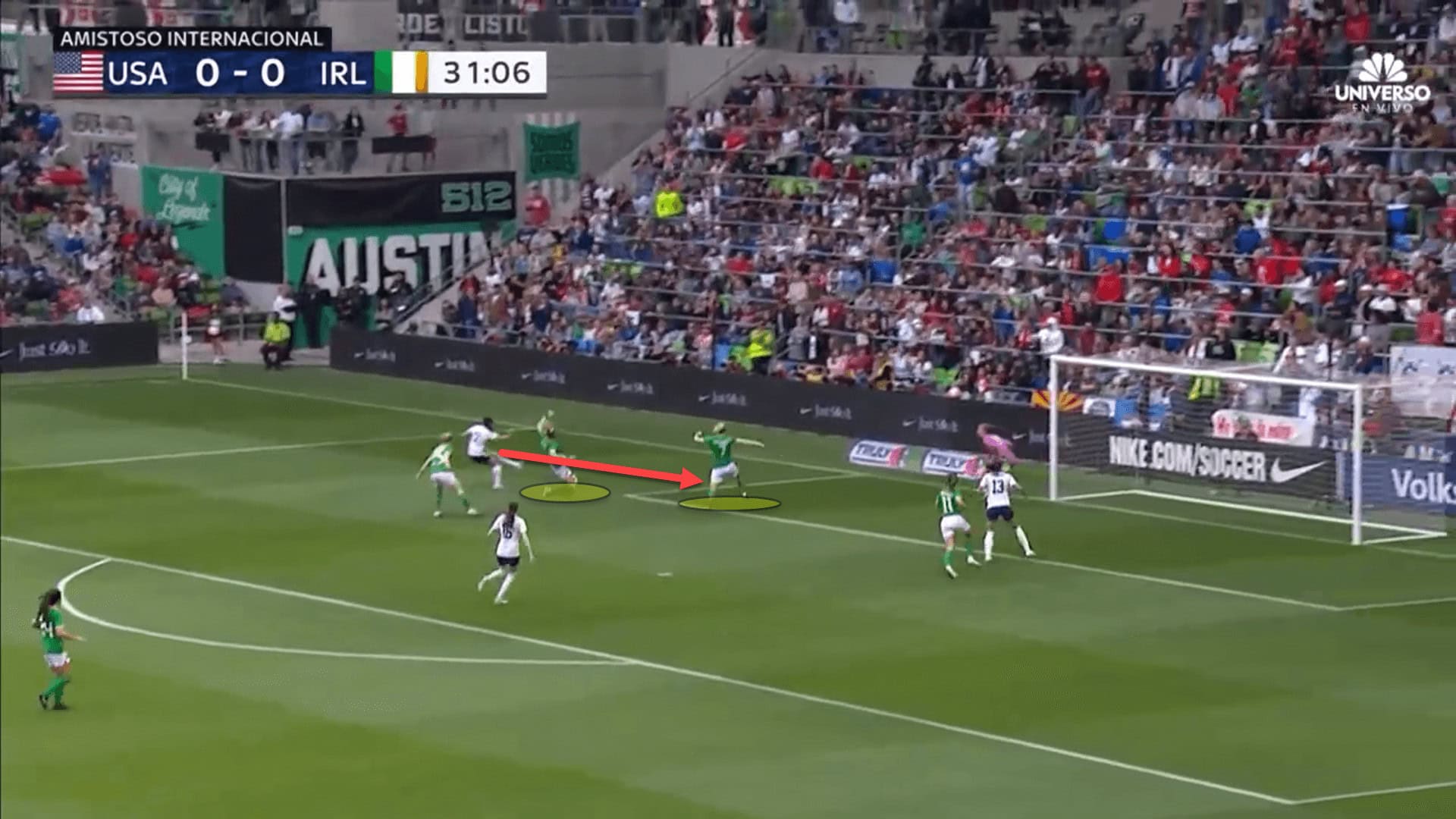
Here, Ireland’s defensive block collapsed and the USA were in an excellent position to open the scoring. However, both Quinn and Caldwell dived at the ball to get a touch to it in the hopes of blocking the shot. Quinn succeeded and the danger was averted.
In this stage of the defensive phase, body position, game intelligence, anticipation and sheer experience are the most important attributes for a defender to have and Ireland possess this in abundance with the likes of Quinn, Mannion and Caldwell at the back.
While Ireland may not have the quality or depth of the likes of England, Australia, the USA, Brazil or Germany, the team work tirelessly out of possession to guard the goal and always move in cohesion, closing off spaces and passing lanes to keep it as tight at the back as possible. This can only be a benefit for Pauw’s girls heading into this summer’s tournament.
Transitions
Transitions are a double-edged sword for the Republic of Ireland. They can be largely beneficial to the team in attack but have also proven to be their downfall in defence. But we’ll start with their attacking transitions.
Given how deep Ireland defend in the 5-4-1 shape, particularly against stronger opposition, as soon as possession is regained, the aim is to hit the ball forward into the channels for the lone centre-forward to latch onto. The hope is that she can either be played through on goal and potentially score or else hold the ball up and wait for more players to join her in attack.
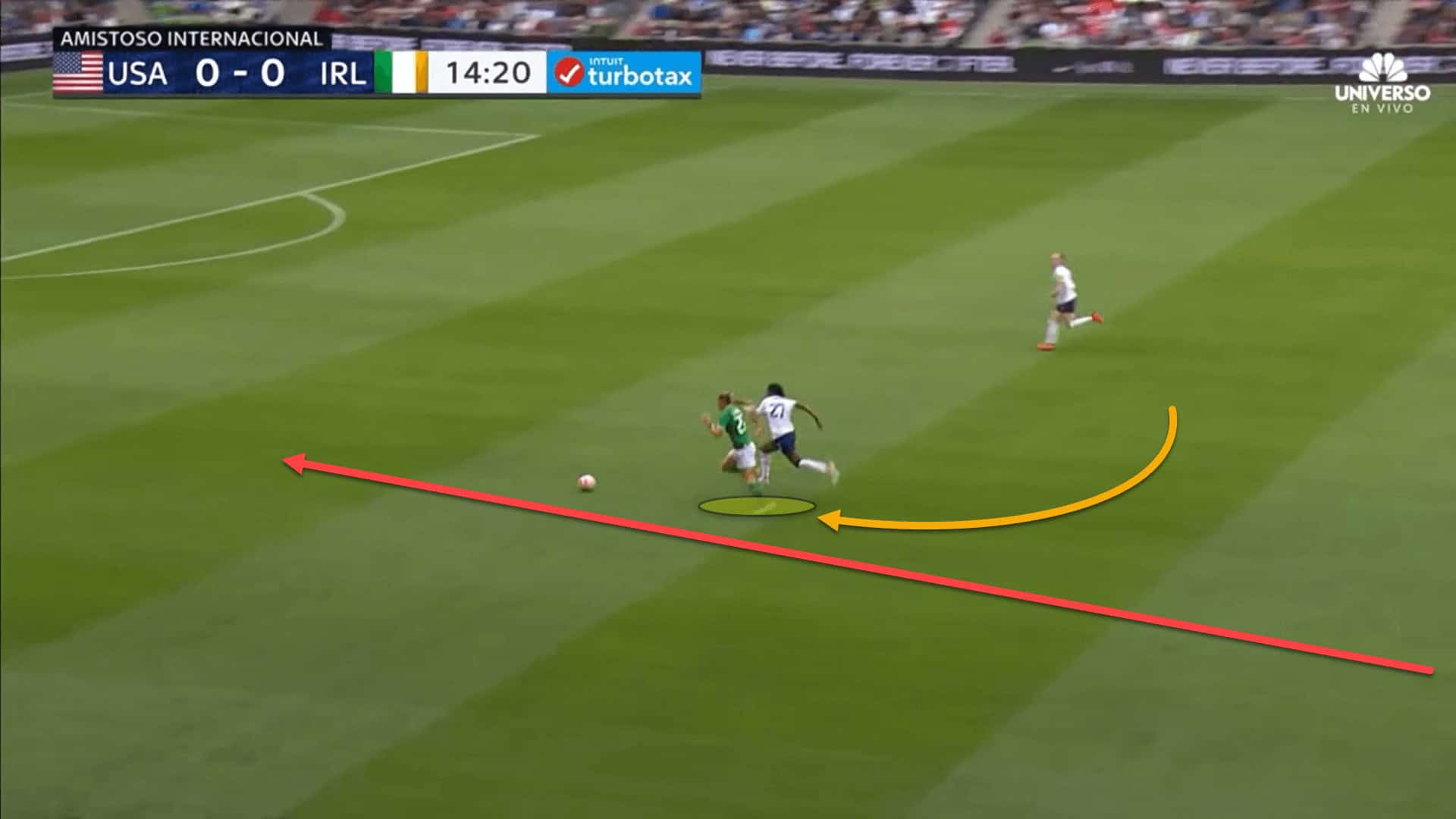
Here, Ireland recouped possession in a deeper area and played the ball in behind for Carusa to chase. Referring back to Karen Duggan’s previous point about Pauw’s tactics, the striker can be left quite ’cold’ in this respect as they may go long periods of the game without receiving a touch of the ball but will still need to chase everything that comes their way, feeding off scraps, as is a common cliché in football.
This strategy may not be everyone’s cup of tea but when it pays off, it really pays off. In fact, in Ireland’s victory versus Scotland back in October, it was this very transitional move which sealed WWC qualification after Barrett was played in behind the Scottish defence.
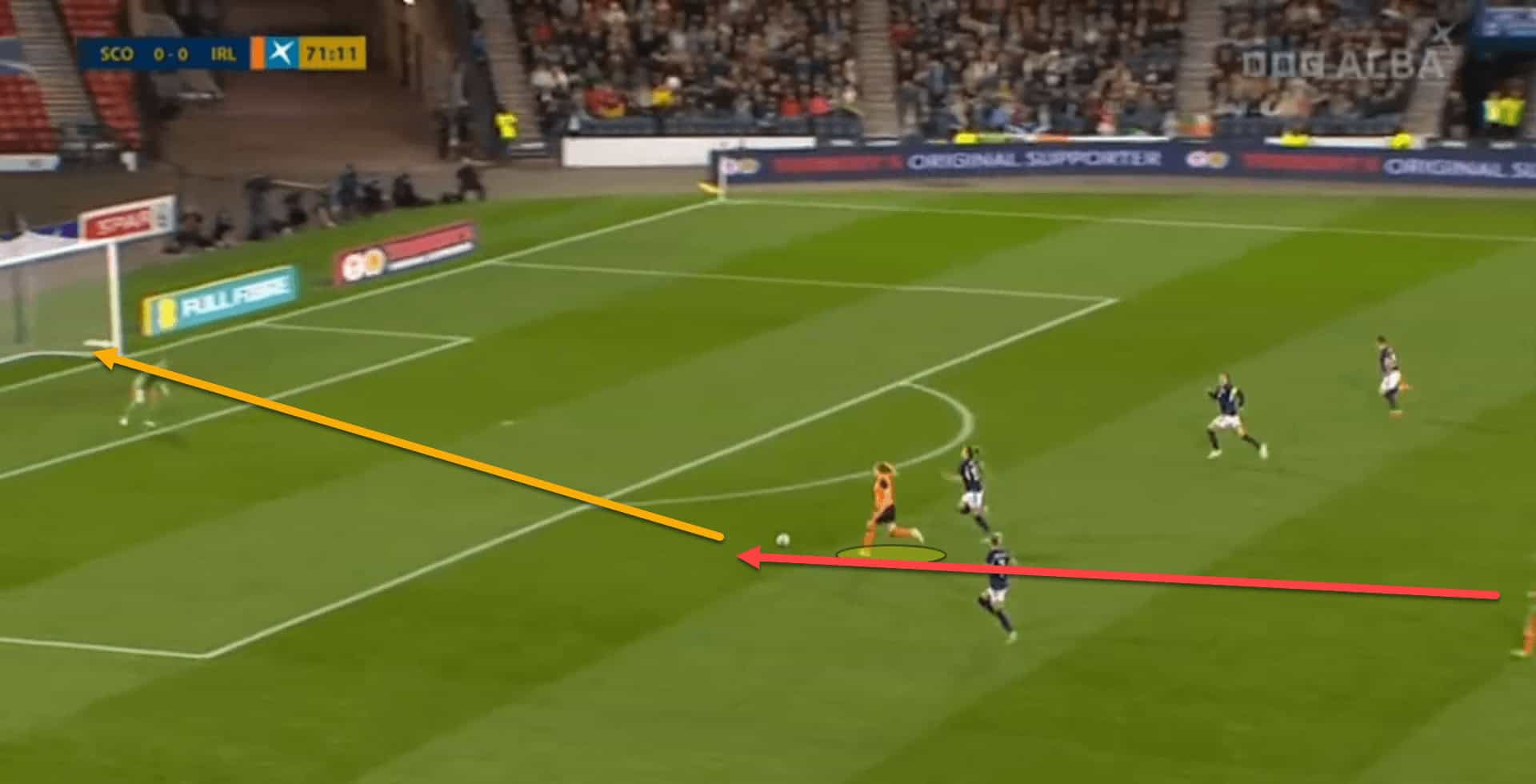
Nonetheless, while Ireland may be effective on the counterattack, they can be quite late to react when the ball is cleared out of their own penalty area.
Full disclosure, we’re about to discuss the team’s struggles when dealing with second balls from the second phase of an opposition attack. These situations are not really defensive transitions but we felt it fit in here better than the previous section.
In the two recent friendlies against the USWNT, Vlatko Andonovski’s side took advantage of Ireland’s struggles to defend second-phase attacks. For instance, there were numerous occasions when Ireland would clear the ball out from the area after a cross was played in but the team didn’t step out quickly enough to win the second ball or block the opposition’s follow-up attack.

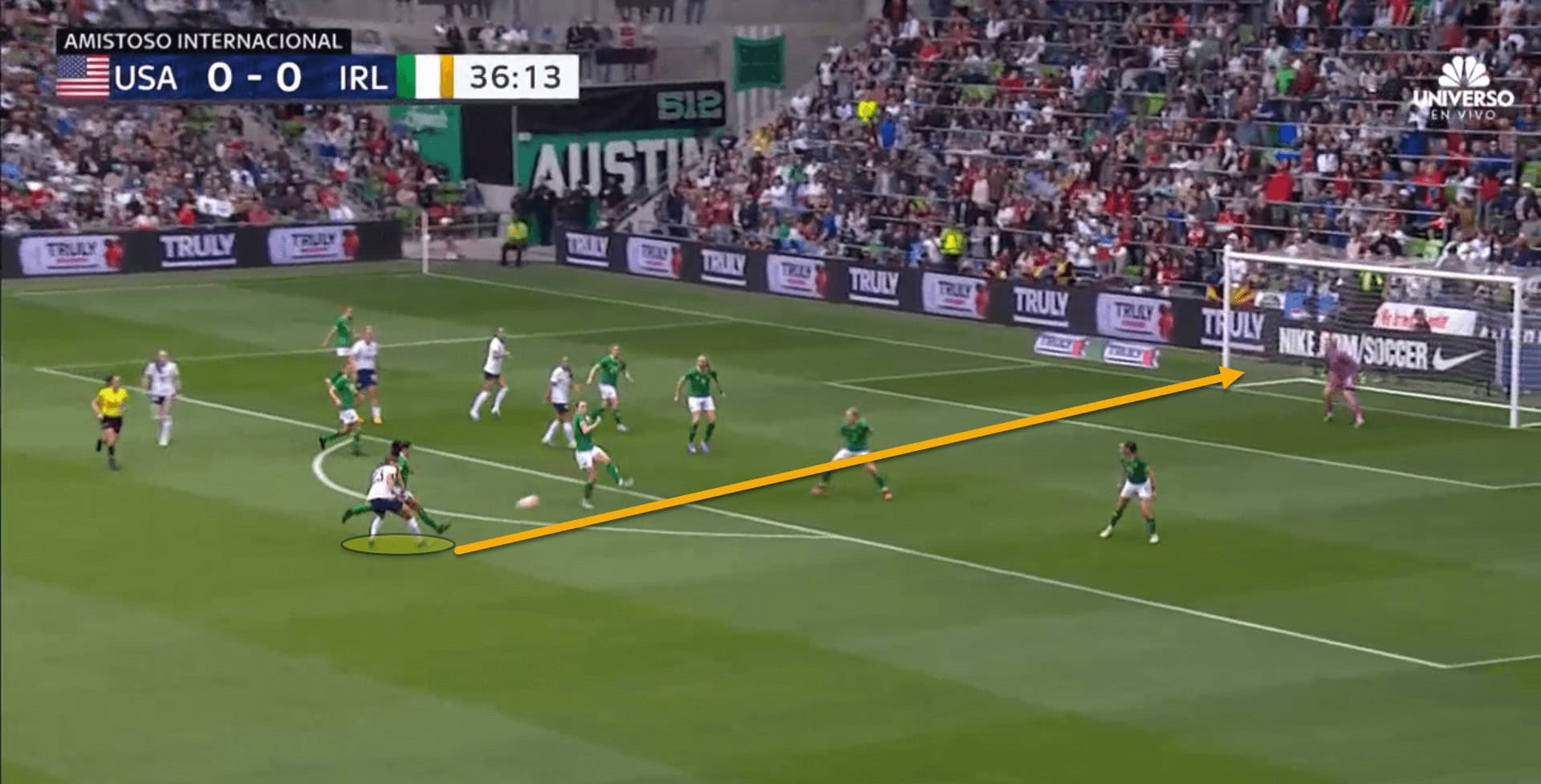
In the first image, Ireland had just about cleared the ball to the edge of the area. The entire side weren’t quick enough to react to the second-phase attack and Emily Fox found enough space to strike the ball low and hard into the bottom-left corner past Brosnan to open the scoring.
This is an area that the team certainly need to improve as it is imperative during low-block defending that the team steps up quickly to stop rebound strikes, especially against sides that attack in waves and waves.
Attackers
As mentioned earlier in this piece, Ireland are outperforming their xG over the past calendar year. Goals have not necessarily been a problem for the Girls in Green. At the World Cup, chances will be few and far between, but this Irish side do have the quality to finish off the opportunities when they present themselves.
Pauw will deploy a lone striker in her 5-4-1 system and will be forced to choose between a number of players such as Carusa and Barrett. Perhaps the Dutch coach will lean slightly towards Barrett considering she scored the all-important goal to help Ireland qualify for the competition almost a year ago.
Midfielders
The midfield will be packed with players who will work hard out of possession as opposed to on the ball. Quality in possession will be secondary, although Denise O’Sullivan will be able to add that little bit of creativity and flair if the rest of the midfield four are lacking. However, O’Sullivan may need a water carrier next to her to do most of the defensive work. A Littlejohn or an Agg will be beneficial in this position.
The wings are potentially the area of the pitch that Pauw changes the most. The likes of McCabe, O’Gorman, Farrelly, Payne and several others within the squad can play in these two roles and so who the head coach starts will depend on the opposition on the day.
Defenders
The defence is undoubtedly the strongest and most important area of Ireland’s side. The likes of Mannion, Quinn and Caldwell are all excellent defenders and will be integral to the team’s ability to keep the ball out of their own goal.
The biggest worry is the fitness of Mannion. As of writing, Mannion has not been included in the Irish provisional squad which is a cause for concern. There is still some positivity that the Manchester United defender will return to action pretty soon and join the rest of the team, but there is also a large possibility that the centre-back doesn’t make it on the plane which could have disastrous repercussions for Pauw’s side.
If all of Ireland’s best defenders are fit, they will have a chance to get a result in each and every game. While it sounds simplistic, if you don’t concede, you can’t lose, and Ireland will be out to claw whatever points they can but they need their best players.
Key Player
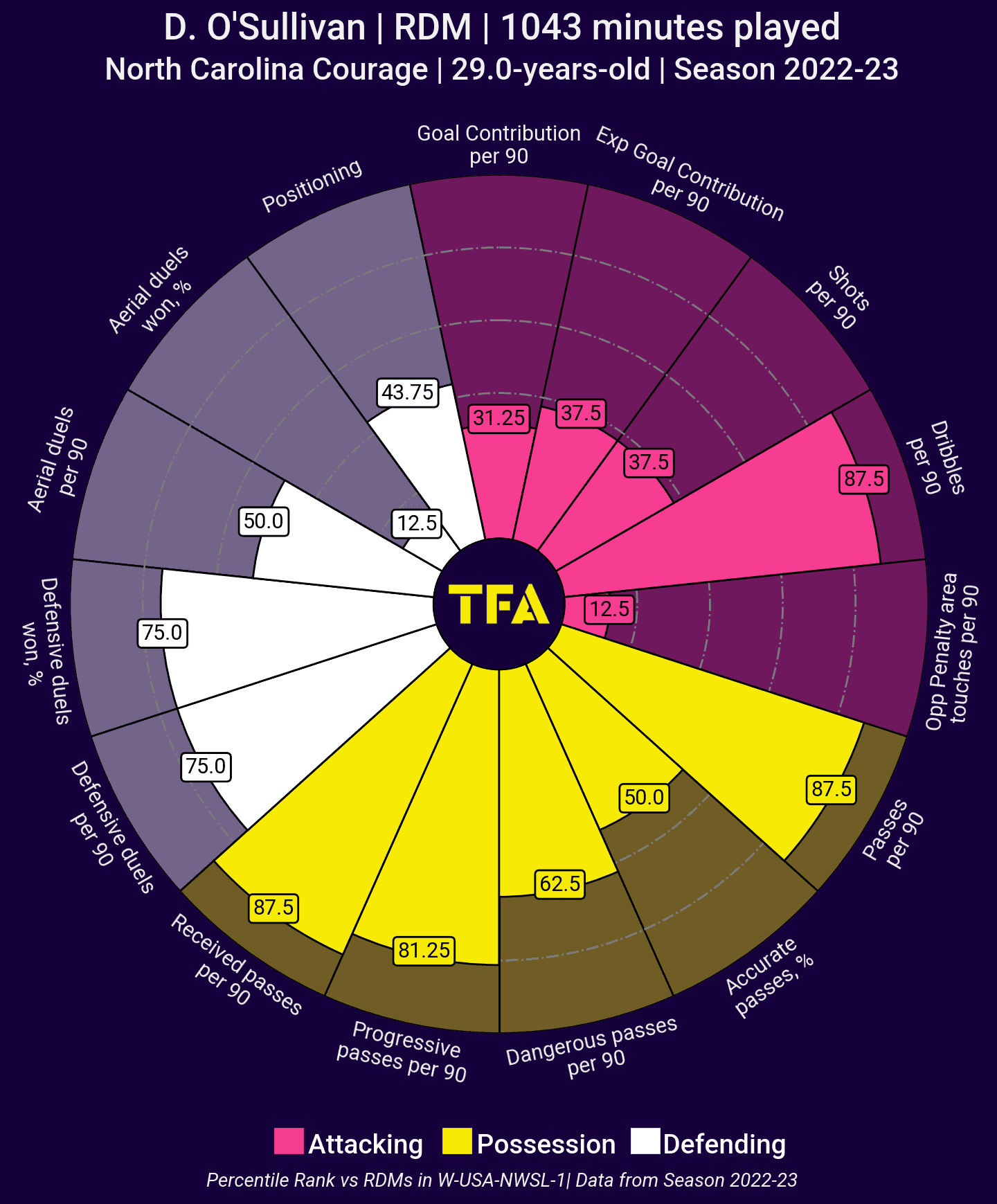
From a technical standpoint, Denise O’Sullivan is potentially Ireland’s best player. The North Carolina Courage midfielder is a true playmaker and can be deadly inside the opposition’s half of the pitch.
Ireland won’t create too many chances at the Women’s World Cup, but we can almost guarantee that the opportunities that are formulated will have O’Sullivan at the source.
Even from an in-possession perspective, O’Sullivan’s ability to find space behind the press and receive the ball with a perfect body orientation before turning and driving forward is unmatched in the Irish squad. O’Sullivan has a wonderful knack for being able to break opposition lines and pass into space if there is a runner searching for a ball in behind.
The 29-year-old Cork woman is irreplaceable in the Irish squad. No other player can come in and fill her boots and without her playmaking prowess and skills in the final third, the Girls in Green would be in a whole host of trouble. So, for that reason, we’ve chosen O’Sullivan as Ireland’s key player to watch out for ahead of the Women’s World Cup.
Tournament Prediction
Getting out of the group will be a gargantuan task for Ireland given the quality of their three opponents. However, it will be the main goal. Nobody expects Ireland to go any further than the first knockout round if they can achieve it, which would be a hell of an accomplishment.
Nevertheless, the Girls in Green must take it one game at a time and try to grind out as many points from their three group games as possible without getting ahead of themselves. But Ireland will have a point to prove that they are not just there to participate and will want to cause a massive upset in the group phase, placing themselves firmly into Irish sporting greatness.

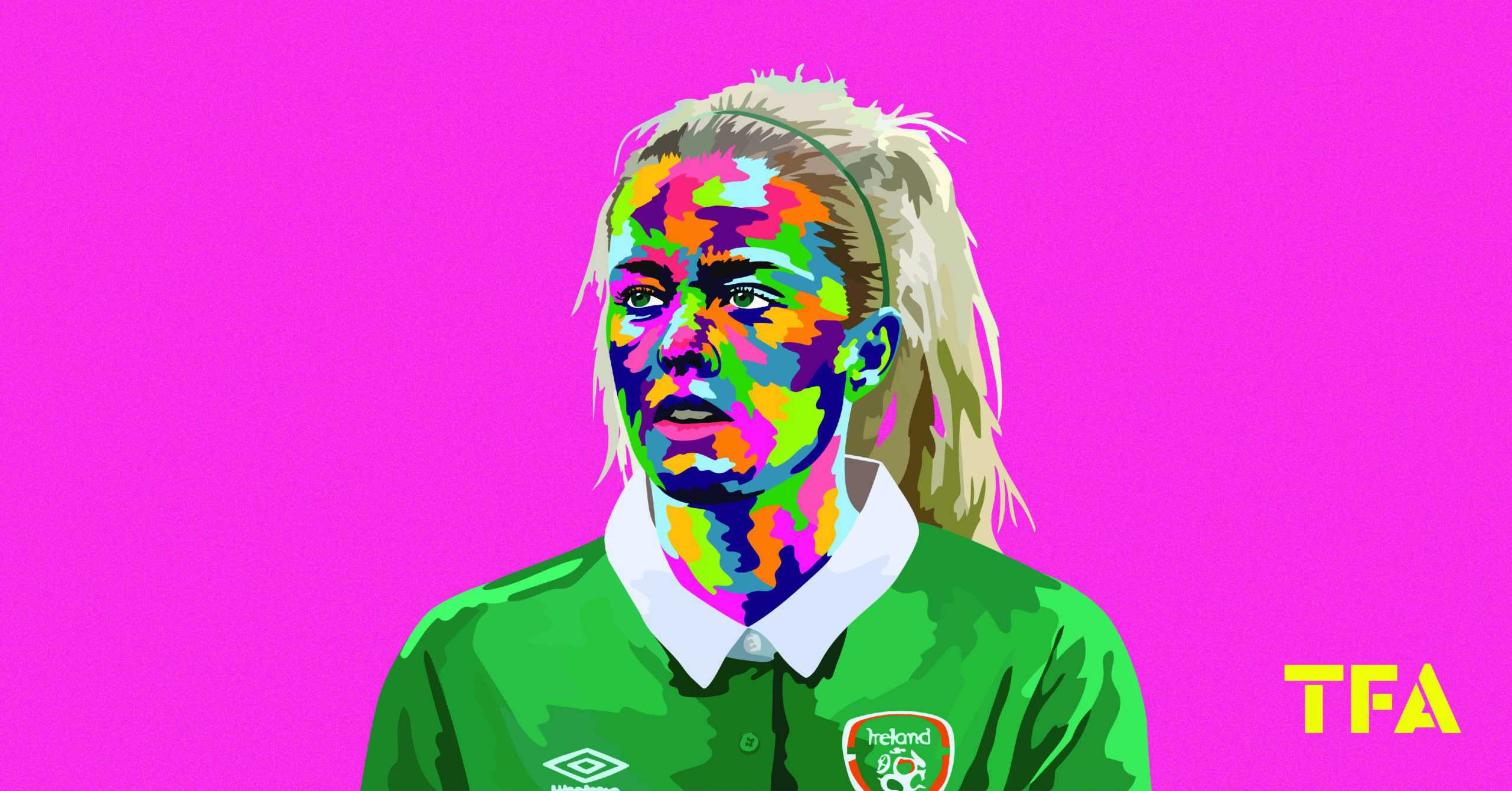




Comments